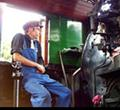The Fireman's Seat
By Robert Bell, Division 15, Assistant Superintendent



I recently tried my hand building my first resin kits. Both were from Funarro and Camerlingo, both are HOn3, and both are models of East Broad Top (EBT) freight cars. Neither came with trucks or couplers.
I had never built a resin freight car kit before, but I have been to several clinics and have read a few articles on the subject. The following are some of my observations and experiences.
First, some things to know: A BIG reason for building a resin kit might be that a model for a specific prototype may only be available in resin. Resin kits are produced in RTV (room temperature vulcanizing) rubber molds from styrene or wood masters. Then a two-part resin, usually a polyurethane resin is poured into the RTV mold. The RTV molds have a limited life, from what I understand, usually around 15-25 uses. Hence, the cost of a resin kit is a bit more than the usual freight car kit. (About the same cost as some of the recent well detailed RTR stuff.) Some resin kits are remarkably simple to build, having as few as three main parts, others have many, many castings. The two I built were somewhere in the middle.
The first kit, I started with was a two-bay hopper for the EBT in Pennsylvania. The kit consisted of castings for two sides, a frame, two ends and two slope sheets. Also included in the kit, was some wire grab-irons, wire, a set of brake details (for this car, incorrect), and of course, instructions. Following these instructions, I used ACC (superglue) to assemble the kit. All went fairly well except one or two of my grab-iron holes came out crooked and hence so did a grab or two, but once the hopper is painted black, I don’t think they will be all that noticeable. Right now the hopper is on hold pending my ordering some specific brass details (brake parts and cut levers) to complete the car.
The other car is a EBT steel boxcar. This kit had a few more parts such as a roof and a roof-walk, and various details for the doors. This time, however, there were no pre-bent grabs. (The EBT had some very unusual grabs on their boxcars.) I tried the wire included with the kit, but, in my eyes, it was too large in diameter, so I substituted .010” music wire, and made a jig for bending it. Steven Funarro told me about a trick to help position certain parts. First, glue a scrap piece of strip styrene to the inside of the resin part with liquid plastic cement. The plastic cement will allow you to position the scrap in place. Note: the plastic cement does NOT “attack” the resin, but it will soften the scrap plastic enough that it becomes “sticky” and will stay in place for a short time. Then secure the scrap with ACC. This really worked well for fitting the frame/floor in place. The instructions for the boxcar were not as “detailed” as I would like, so now I need to order a particular book covering some of the details of these cars and I need some of the same details as for the hopper.
In the end, I will have two very unique pieces of rolling stock that will be well detailed. It took about an hour almost every night over the course of three weeks or so to get both cars to the point where I am with them. Don’t get one and expect it painted, weathered and in revenue service on your layout in two hours time. Resin kits are not for the faint of heart, but neither are they just for the “experts”. In this day of “ready-to-run, I don’t even have to add the handrails, super priced models”, resin kits offer a chance for a bit of “quality time” with our trains. Try one and see.
In the June Fireman’s Seat, we’ll talk about some cool tools useful in modeling. Until then, remember: It’s your club - get involved! Let’s play trains!